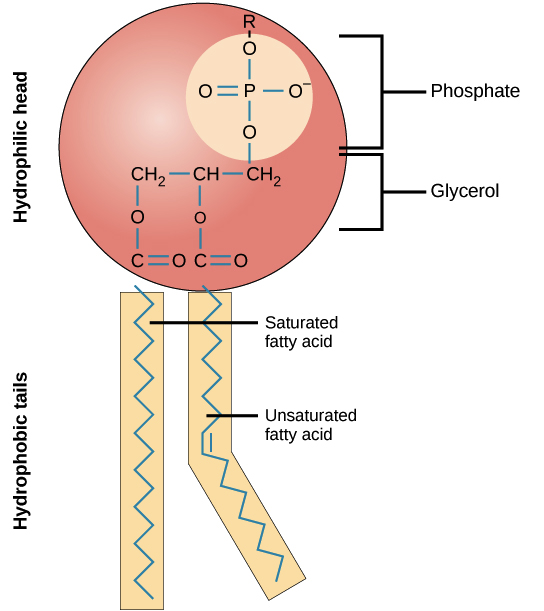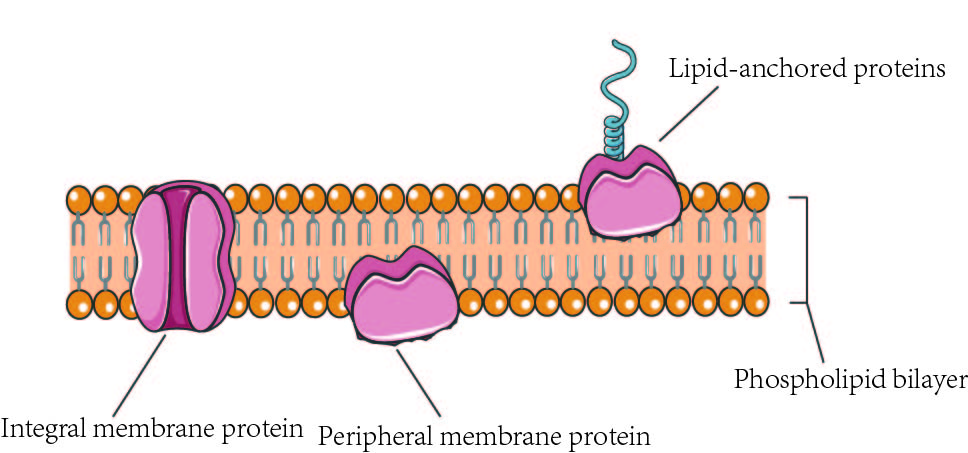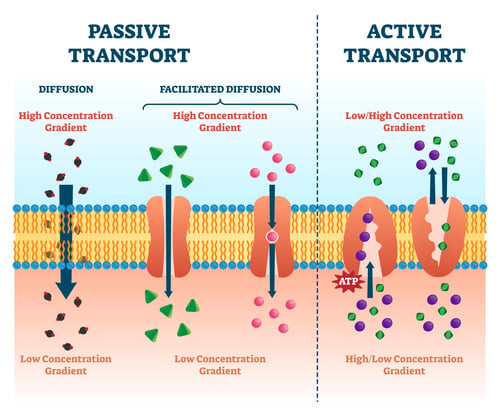Core Concepts
This article will discuss biological membranes including their structure, composition, function, and types of transport that occur across cellular membranes.
Topics Covered in Other Articles
Introduction to Biological Membranes
Biological membranes are a fundamental structure in all cells, serving as an interface between the intracellular environment and the external world. Membranes are composed of a phospholipid bilayer and are integral to numerous cellular functions. Beyond the cell, biological membranes have inspired various real-world applications. One example is in targeted drug delivery systems, in which researchers have developed lipid-based nanoparticles that mimic cell membranes to encapsulate drugs, ensuring targeted delivery and controlled release within the body.
Structure and Composition of Membranes
Biological membranes are primarily composed of a phospholipid bilayer with various proteins, carbohydrates, and cholesterol molecules embedded within them. The phospholipid bilayer forms the backbone, with hydrophilic heads facing outward toward the aqueous environment and hydrophobic tails facing inward, away from water. This arrangement creates a semipermeable membrane, allowing selective passage of substances.

Phospholipids, the most abundant type of lipid found in the bilayer, have a hydrophilic phosphate head and two hydrophobic fatty acid tails. Hydrophobic interactions (where the hydrophobic tails avoid water and aggregate together) drive the spontaneous formation of the bilayer. This arrangement minimizes the free energy of the system. Additionally, van der Waals forces between the fatty acid tails further stabilize the bilayer. Hydrogen bonds and electrostatic interactions among the polar phosphate heads also contribute to the overall stability and integrity of the bilayer, ensuring a strong yet flexible barrier.

Embedded within this bilayer are proteins that serve multiple functions, including acting as channels/receptors for transport, signal transduction, and providing structural support. Membrane proteins can be peripheral (loosely attached to the membrane’s surface) or integral (spanning the membrane).

Carbohydrates, often attached to lipids or proteins, extend from the cellular surface, playing key roles in cell-cell recognition and communication. Cholesterol molecules, dispersed within the bilayer, contribute to membrane fluidity and stability. All together, these components create a dynamically functioning barrier essential for maintaining cellular integrity and facilitating these processes.
Functions of Biological Membranes
Biological membranes play a crucial role in maintaining the integrity and functionality of living systems and their cells. These membranes serve as selective barriers that regulate the passage of substances in and out of cells and organelles. They facilitate both communication and signal transduction through receptor proteins, allowing cells to respond to external stimuli. Membranes also provide structural support and compartmentalization, enabling metabolic processes to occur in specialized environments. Additionally, they play a role in energy conservation and conversion, such as the mitochondrial inner membrane where ATP synthesis occurs.
Selective Permeability
Selective permeability of membranes is a fundamental feature that allows cells to regulate the movement of substances in and out of the cell, ensuring homeostasis and proper cellular function. This property is mainly facilitated by the phospholipid bilayer, which acts as a barrier to water soluble molecules while allowing lipid-soluble molecules to pass through more freely. Embedded proteins play a role in both passive and active transport (two forms of biological transport). Passive transport, including diffusion and facilitated diffusion, occurs without energy expenditure as molecules move down the gradient through protein channels. In active transport, energy often in the form of ATP is used to move substances against their concentration gradient. This is accomplished via transport proteins such as pumps (like the sodium potassium pump).

Additionally, structural fluidity provided by cholesterol molecules within the membrane enhances the dynamic function of these transport proteins, allowing the membrane to adapt and respond to the cell’s molecular needs. Thus, selective permeability of biological membranes is essential for an efficient and regulated transport process.
Signal Transduction
Signal transduction is the process by which cells respond to external signals, and biological membranes play a crucial role in this communication system. Membrane proteins, specifically receptors, span the cell membrane. These extracellular domains are designed to detect specific signaling molecules, such as hormones, neurotransmitters, and growth factors. Upon binding to the signaling molecule, the receptor undergoes a conformational change that transmits the singla across the membrane to its intracellular domain. This triggers a cascade of intracellular events often involving secondary messengers like cyclic AMP or calcium ions, which amplify and propagate the signal to elicit a cellular response. This response can include changes in gene expression enzyme activity, or ion channel permeability, ultimately affecting cell behavior and function.

Cholesterol and lipid rafts within the membrane also contribute to signal transduction by organizing and concentrating signaling molecules for efficient interaction. Thus, biological membranes not only serve as physical barriers, but also dynamic platforms for signaling, allowing cells to adapt and respond to their environment.
Energy Conversion
Biological membranes are also central to the process of energy conversion in cells, particularly in ATP production. In eukaryotic cells, the inner membranes of mitochondria and chloroplasts are key sites for energy conversion. The mitochondrial inner membrane houses the electron transport chain (ETC) and ATP synthase, essential components of oxidative phosphorylation. During this process, electrons move through protein complexes in the ETC. This movement creates a proton gradient across the membrane. The energy from this gradient drives protons through ATP synthase thus synthesizing ATP. In plant cells, thylakoid membranes in chloroplasts are crucial to photosynthesis. Light dependent reactions generate a protein gradient across the thylakoid membrane, also powering ATP synthase to produce ATP.
